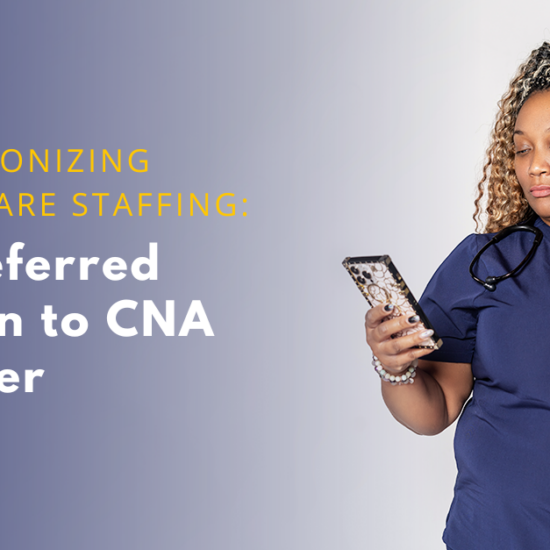Non-Negotiable Needs For Senior Care Staffing Stability
New SNF Industry Report Highlights Non-Negotiable Need For Senior Care Staffing Stability To Offset Significant Profit Loss
The skilled nursing industry’s challenges around recruiting and retaining direct-care workers were only magnified during the pandemic. And unfortunately, organizations don’t seem to be faring much better in this post-pandemic environment.
While healthcare systems across the nation were hit hard by the pandemic, the nursing home population was among those at highest risk. Residents were often confined to their rooms while the virus spread throughout the community, causing them and staff to fall ill. We all know how dire this situation was, so we’ll spare you from reiterating the details. However, a subtle reminder helps to make the case for why some chose jump ship for higher paying hospital jobs or leave the healthcare industry altogether.
This mass exodus forced organizations to hire contract workers to fill senior care staffing and healthcare staffing gaps, a practice that is not only costly, but many believe can compromise quality and continuity of care. Agency workers are not familiar with the staff, resident needs and the other nuances of each community they step foot in.
Still, this seemed to be the only viable option at the time and appears to be the approach that many organizations are still taking today. A new report breaks down the impact this trend has had on Skilled Nursing Facilities (SNFs) over the past few years. In the 37th SNF Cost Comparison and Industry Trends Report, CliftLarsonAllen analysts paint the picture of an industry that is truly “at a crossroads.” Here are a few takeaways from their findings.
Despite Increase in Contract Labor, RN Senior Care Staffing Hours Remained Low
“Approximately 100 million fewer nursing hours were paid within the SNF industry from 2020 to 2021 — a 7.5% reduction. This measure includes hours of employed nursing staff as well as hours filled by contract labor,” the report reads.
This means that despite organizations resorting to using agency workers, there did not seem to be enough available talent to go around.
The analysts also found that in 2021, 5.5% of all nursing hours were filled by contract labor, a whopping 83% increase from the median 2020 contract labor utilization. To put that into a dollar amount, nursing contract labor expenses increased approximately 64% from $2.2 billion in 2020 to $3.6 billion in 2021. That’s because approximately 30% of SNFs were paying more than $70 per hour for these services, according to the report.
What’s more, facilities saw an increase in long-term stay Medicaid residents, whose payor does not fund the actual cost of care in most states. “Therefore, with labor and supportive services costs increasing, limited staffing, and a shift to predominantly Medicaid residents, increased occupancy cannot be supported,” the report says.
Inflation, Rising CPPD & Retracted Relief Funding Cause Further Financial Setbacks
Rising costs in other areas are also impacting providers’ margins and ability to remain viable. The total cost per patient day from 2019 to 2021 has increased 28% or $73 per day compared to the predictable 3% increase between 2018 and 2019, the report reads. Unfortunately, while expenses – related to both staffing and caring for patients – continue to climb, the rate of reimbursement remains stagnant.
“SNFs predominantly rely on government payors whose reimbursement does not adjust in correlation with the cost inputs of operating a SNF,” the report explains. “The headwinds SNF providers navigated through 2021 continue to pressure operating margins. PHE funding allowed SNFs to overcome some challenges; however, with the expiration of the majority of PHE funding programs, SNF providers will likely face continued financial strain.”
The authors also point out the fact when reimbursement rates were set at the beginning of 2021, facilities were caring for a large population of Medicaid residents. This “greatly impacted reimbursement.”
So, while wages for direct-care staff, specifically contract nurses, continue to climb, organizations no longer have the additional pandemic relief funds to keep up.
More Staffing Mandates Are on the Horizon
Despite the fact that the SNF industry is operating in crisis mode – a from “occupancy growth mode” to “no margin, no mission,” as the authors call it – the Biden administration has proposed a federal minimum staffing requirement. The language in the mandate makes no mention of additional funding to support organizations moving forward.
The mandate proposes 4.1 productive staffing hours per day, which according to the report, would mean the following:
- 94% of nursing homes that care for more than 900,000 residents would need to increase staffing levels to be in compliance
- It would cost $10 billion a year and require hiring more than 187,000 nurses and nurse aides to meet the standard
Solve The Senior Care Staffing Puzzle, Save The Struggling SNF Industry?
The nation has long grappled with the solution to overcoming the staffing crisis, yet no one seems to have the solution. And while effectively pushing the mission of senior care to attract people to this fulfilling and essential line of work is critical, fruits of this labor will take time. Right now, organizations must focus on properly staffing their facilities to provide quality resident care and keep their doors open by any means necessary.
NurseDash Can Help Today
Contract work appears to be here to stay. But that doesn’t mean you have to rely on the outdated, costly models of the past to fill your open shifts. Traditional staffing agencies are expensive and don’t guarantee the person you are bringing into your community is highly qualified to meet the needs of your residents.
NurseDash is the future of contract work. We are a healthcare marketplace built specifically to meet the staffing needs of organizations by offering on-demand, highly vetted workers at a fair price. NurseDash clinicians go through background screenings as well as credential and license monitoring so you can feel confident those entering your community are there with one goal in mind: providing excellent resident care. And since we cut out the middleman associated with agencies, facilities using our technology see a 30% cost savings on average compared to those using a traditional staffing agency.
With our approach, facilities can directly communicate their openings with available nurses, who can then self-select the shifts that work best for their schedule. The provides caregivers with a new level of flexibility and helps them avoid burnout and offers superior work-life balance.
Interested in learning more? Apply today if you’re a healthcare professional. Contact us if you need staffing assistance.






